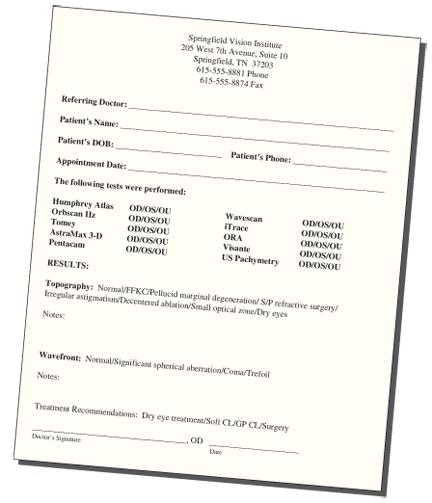
When communicating with another doctorwhether an ophthalmologist, a primary-care physician, a specialist, or another optometristconsider each communication an opportunity to obtain the best care for your patient, to display your competence, to open lines of communication, and to market yourself.
We owe it to our patients, and to ourselves, to communicate properly with our fellow doctors. When we fail to communicate clearly or politelyor fail to communicate at allwe do a disservice to our patients and to ourselves.
This third installment of Review of Optometrys Role Playing series explains howand whyto communicate properly with other doctors.
First, Talk to the Patient
When you refer a patient to another physician, be sure to educate the patient about the reason for referral. This helps ensure that the patient sees the doctor, communicates your concerns with that doctor, and returns to you after the encounter (if thats your intention).
This is especially true when sending the patient to another eye doctor. For example, if you refer your patient to the binocular vision specialist in your area, tell the patient that youre sending her to a specialist who cares for patients with double vision, and after the double vision is resolved, youll see her again. When referring the patient for surgery, discuss the comanagement of care before the patient sees the doctor so the patient understands you intend to perform postoperative follow-up.
Also, dont neglect to refer to other optometrists. Find out what your local O.D.s specialize in, such as low vision, binocular vision, sports vision, contact lenses or pediatrics. Reach out to them when you have a patient in need of their services.
Put It in Writing
Once you decide to refer a patient, let the doctor know by telephone or in writing. (Text messaging is not professional, IMHO.) Calling a doctor may be easy, but actually talking with the doctor can be difficult. Very often, the only person youll talk to is the doctors assistant who tells you, time and again, The doctor is with a patient. Instead of calling repeatedly, leave a short voice mail and let the doctor know youre following up with a letter.
When writing a letter, several basic guidelines apply:
Say thanks. If a doctor refers a patient to you, write a letter in response. Most insurance plans require this for documentation of an office visit. In addition, a referral from another doctor indicates a sense of trust, and as with any business transaction, a thank-you is customary.
Be prompt. Send letters in a timely manner. Delays imply disorganization and incompetence.
Clearly identify the patient. Identify the patient using both name and date of birth, and give the appointment time if appropriate. For administrative ease, we include copies of both our patient information sheet and the patients insurance card.
Fax the facts. If time doesnt permit you to write a formal letter, such as when referring a patient for retinal detachment, send the clinical notes via fax and with the patient to ensure that the doctor obtains the information.
State your case. Open the letter stating the reason for referring the patient, and close the letter by describing what you expect of the physician. If nothing else, readers typically read the first sentence and the last paragraph.
Always proofread. Spell check is beneficial, but not infallible. Proof the letters before mailing to avoid misspellings and grammatical errors. This is especially important when using a template or form letter to ensure the patients name is used throughout the letter, and the proper pronouns are used when referring to the patient.
Add essential reports. Include necessary attachments, such as topographic maps, visual field results or other printouts, for the doctors records. This is especially important when youre using technology that the doctor may not have access to.
Its nothing personal. Dont include personal discussions in your professional correspondence. Dont bring up your daughters ballet lessons or when you last saw each other at the gym. Its fine to be friendly, but keep it professional.
Select a sole correspondent. Put only one staff person in charge of outgoing correspondence. This keeps one person in control of the process, and one person to go to when problems arise. This way, its easier to identify problems and to be more efficient.

Use a report form, like this one, for documenting common tests. Create a form that is quick to read and easy to understand.
Use EMRs
Many electronic medical record (EMR) programs make it quick and easy to create clinical reports and letters to physicians. Frequent communication with a physician about your mutual patient puts your name in that doctors mind when someone asks for a referral or when that doctor needs a consultation later on for one of his patients.
This can be easily done with an EMR system that includes a letter-writing application. With just a few mouse clicks, you can create a referral letter or a thank-you note to another physician for his or her referral.
Such a program enables you to use it both as a marketing technique and to develop relationships with area doctors. You can include the full patient clinical note, or just the assessment and plan information. You can easily include patient information sheets as attachments as well.
Letters to Ophthalmologists
When sending a patient to a surgeon, include your reason for referral in the letter, and make your intentions clear. Are you referring for a second opinion, or are you referring for diagnosis and management of the problem? While this may be clear for cataract surgery, it may be less obvious when referring a patient for evaluation of retinal hole or duct obstruction.
Include pertinent information only. Despite what we learned in optometry school, the AC/A ratio is not important for every patient. A retinal surgeon does not need to know your patients results on stereopsis testing, and a neurologist may not need retinal OCT results.
Note what attachments you plan to include by listing them at the bottom of the letter, as well as the name and address of any doctors that you carbon copy. This will also aid your staff member who sends out the letters.
Reports from new or uncommon technology, such an Ocular Response Analyzer (Reichert) or Visante OCT (Carl Zeiss Meditec), may require an extra explanatory paragraph or report for the doctor. If you intend to add such information frequently, use a template report form. (See example of a topography and wavefront report, opposite page.)
Create a form that is quick to read and easily understood. It should explain the test, indicate why the test was performed, and clearly state the results.
Letters to PCPs
Speak the language of the doctor. Dont include refractionsphysicians dont understand them. Instead of O.D. and O.S., use right eye and left eye. Describe the vessels and maculae rather than reporting 2/3 AV with (+) FLR O.U.
Let the doctor know youre in control. Outline the diagnosis, review the pertinent medical facts, and outline your treatment plans. If your plans are not clear, the physician may refer the patient to an ophthalmologist of their choice.
When referring for systemic work-up of eye disease, outline the etiology in a manner that suggests youre aware that the physician should be well versed on the topic, but you are simply trying to be helpful. This is not to say that the PCP is unable to handle the situation; rather, explaining the patients condition in your letter is simply another method of reasserting both your responsibility for the patient and your professional capability.
But, be careful not to appear condescending when suggesting ancillary testing to aid in the clinical diagnosis and management of the patients ocular problems. A physician may be put off by a statement like, I am sending my patient back to you for the following tests to investigate the etiology of her iritis. Instead, write, I am referring our mutual patient to you for testing to help us identify the cause of her iritis.
Faxing is Frugal
Mailing letters for nearly every patient can be expensive given the cost of stationary, postage and staff time. You may be able to fax letters with attachments to doctors and save these costs.
Consider using black-and-white stationary on plain paper for this purpose rather than expensive formal stationary on bond paper. The letterhead looks the same but is considerably less costly, and you only require one copy of the letter for the paper chart. Better yet, fax directly from your computer.
The Outgoing Type
Consider a transcription service if you cant type or cant find time to type. Even if you can type, or have a whiz of an assistant, transcribing may be a more cost-effective method to complete your correspondence.
In many cases, you simply call a local or toll-free phone number and dictate your letters. Letters may be transmitted to your computer via a secure connection, so you can review and edit them. Once you approve them, you can have a staff member print them out. To speed up the process, you can even create a digital image of your signature and insert it into the letters (provided you trust the staff member who has access to the image file).
Another option for those with slow typing skills is voice recognition software, such as Dragon NaturallySpeaking for PCs and iListen for Macs. If youre in the market for a new computer, Windows Vista actually incorporates this technology and additional software programs may not be necessary. These software packages use a microphone to capture your speech. The program types the words you speak into a text document on your computer. Some packages transcribe digital recordings as well. Tutorials are important because you need to train the computer to understand your speech patterns and build a vocabulary. Voice recognition software may be more time consuming at the beginning, but may save you considerable time later.
Let Letters Market You
Use every letter as an opportunity to market your practice. Doctors wont know that you renovated your office, that you recently obtained advanced diagnostic equipment, or that you added a satellite office if you dont tell them. So tell them. If you like, add a second page that includes this information. Mention the different applications of your new instrument. Inform them of your ability to fit scleral lenses or to assess computer vision syndrome. If you have a quarterly newsletter or a flyer, consider including it with the letter.
When you report the results of medical visits to the patients general physician or specialist, it educates them about the optometrists role in systemic health. Many internists do not know optometrists perform diabetic evaluations or treat glaucoma. Pediatricians wont send you children with pink eye unless you tell them you see these patients.
The bottom line: Physicians expect correspondence, even if they dont read it word for word. Speak their language. Be concise and direct. It ensures the continuity of your patients care, and its an excellent opportunity to encourage other doctors to refer you a patient in need of eye care.
Dr. Swartz was the clinical director of the Wang Vision Institute,

